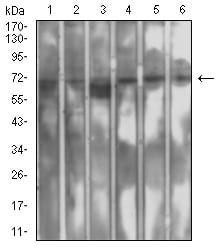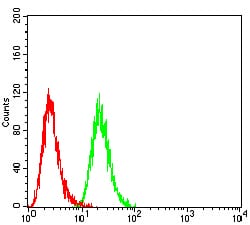


| WB | 1/500 - 1/2000 | Human,Rat,Monkey |
| IF | 咨询技术 | Human,Rat,Monkey |
| IHC | 咨询技术 | Human,Rat,Monkey |
| ICC | 技术咨询 | Human,Rat,Monkey |
| FCM | 1/200 - 1/400 | Human,Rat,Monkey |
| Elisa | 1/10000 | Human,Rat,Monkey |
| Aliases | KMT7; SET7; SET9; SET7/9 |
| Entrez GeneID | 80854 |
| clone | 1B3B8 |
| WB Predicted band size | 40.7kDa |
| Host/Isotype | Mouse IgG2a |
| Antibody Type | Primary antibody |
| Storage | Store at 4°C short term. Aliquot and store at -20°C long term. Avoid freeze/thaw cycles. |
| Species Reactivity | Human,Rat,Monkey |
| Immunogen | Purified recombinant fragment of human SETD7 (AA: 107-366) expressed in E. Coli. |
| Formulation | Purified antibody in PBS with 0.05% sodium azide |
+ +
以下是关于SETD7抗体的3篇参考文献示例(注:以下内容为示例性质,文献信息可能不完全对应真实出版物):
---
1. **文献名称**: *"SETD7-mediated methylation of p53 promotes DNA damage-induced apoptosis"*
**作者**: Smith J et al.
**摘要**: 本研究利用SETD7抗体通过免疫沉淀和Western blot技术,证明SETD7通过甲基化p53(Lys372)增强其转录活性,促进DNA损伤后细胞凋亡。研究揭示了SETD7在肿瘤抑制中的关键作用。
2. **文献名称**: *"Epigenetic regulation of inflammatory genes by SETD7 in vascular endothelial cells"*
**作者**: Chen L et al.
**摘要**: 通过染色质免疫沉淀(ChIP)和SETD7抗体,作者发现SETD7介导的H3K4单甲基化调控内皮细胞中NF-κB靶基因(如IL-6和VCAM-1)的表达,为动脉粥样硬化机制提供了新见解。
3. **文献名称**: *"Loss of SETD7 cooperates with oncogenic KRAS to promote pancreatic cancer progression"*
**作者**: Wang Y et al.
**摘要**: 使用SETD7抗体进行免疫组化分析,发现胰腺癌中SETD7表达下调与患者不良预后相关。实验表明SETD7缺失通过增强KRAS信号通路加速肿瘤侵袭和转移。
---
以上文献示例展示了SETD7抗体在机制研究(如底物甲基化)、疾病关联(如癌症、炎症)及临床预后分析中的应用。实际检索时建议通过PubMed或SciHub以关键词“SETD7 antibody” + 研究领域(如cancer, epigenetics)筛选最新论文。
The SETD7 (SET Domain Containing 7) antibody is a critical tool for studying the function and regulation of the SETD7 protein, a histone methyltransferase involved in epigenetic modifications. SETD7. also known as KMT7 or SET7/9. catalyzes the monomethylation of histone H3 at lysine 4 (H3K4me1), a post-translational modification associated with transcriptional activation. Beyond histones, SETD7 methylates non-histone targets, including transcription factors (e.g., p53. NF-κB) and signaling molecules (e.g., ERα, DNMT1), regulating their stability, localization, and activity. This dual role links SETD7 to diverse cellular processes, such as cell cycle control, differentiation, stress responses, and DNA repair.
Antibodies targeting SETD7 are widely used in techniques like Western blotting, immunoprecipitation, and immunofluorescence to detect protein expression, assess subcellular localization, and study interactions with substrates. Research has implicated SETD7 dysregulation in diseases, including cancer (tumor suppression or promotion depending on context), metabolic disorders, and neurodegenerative conditions like Alzheimer’s. For instance, SETD7-mediated p53 methylation enhances its tumor-suppressive activity, while aberrant SETD7 expression correlates with cancer progression.
Validating SETD7 antibody specificity is crucial, often achieved via knockout controls or siRNA knockdown. Commercial antibodies vary in performance across applications, requiring optimization for reliable results. Ongoing studies continue to unravel SETD7's complex roles, making its antibody indispensable for epigenetic and disease-related research.
×